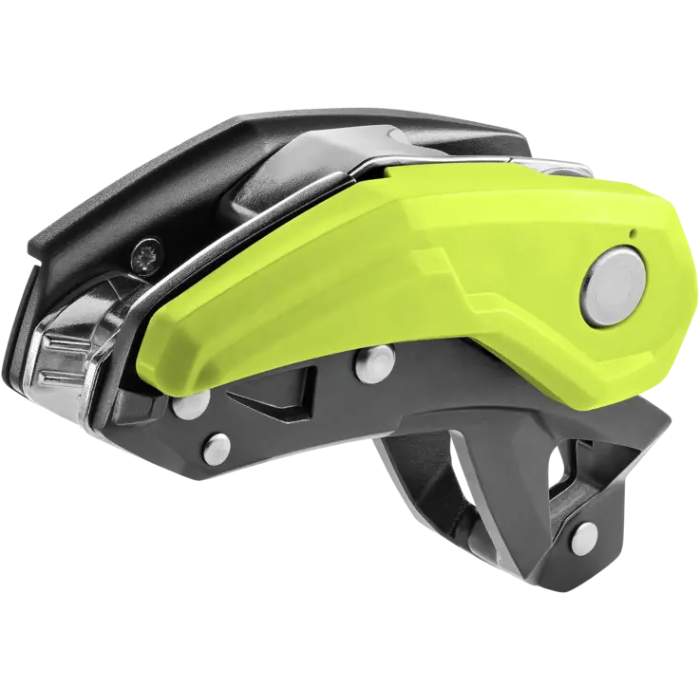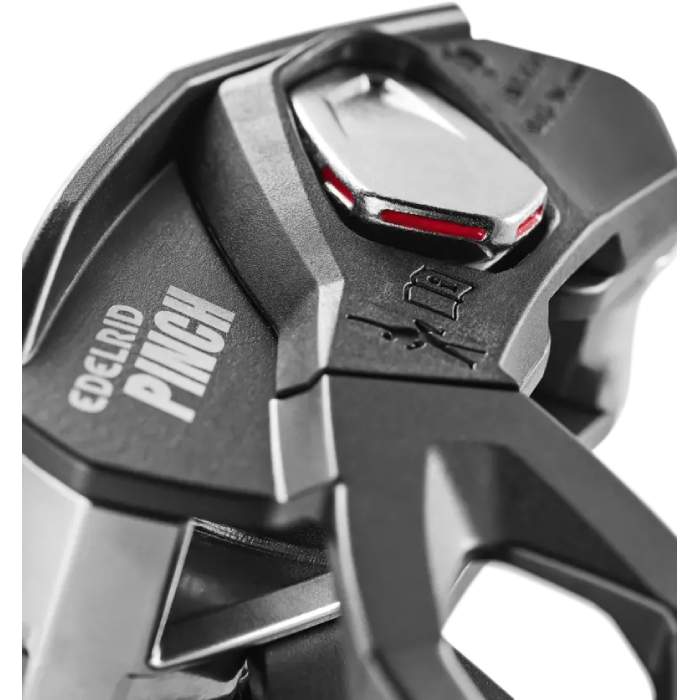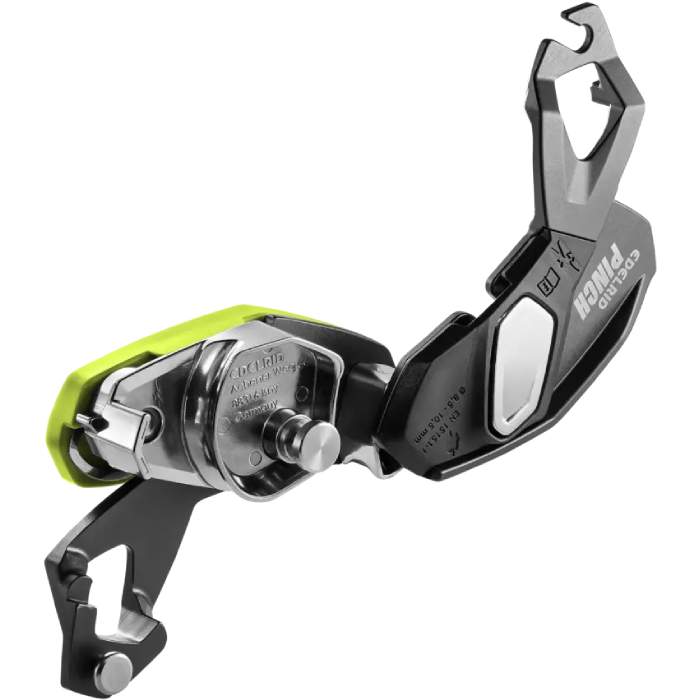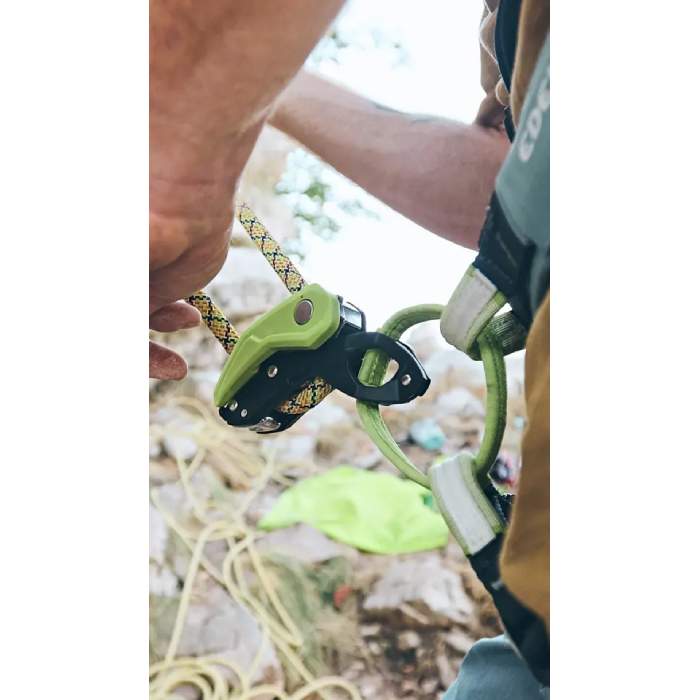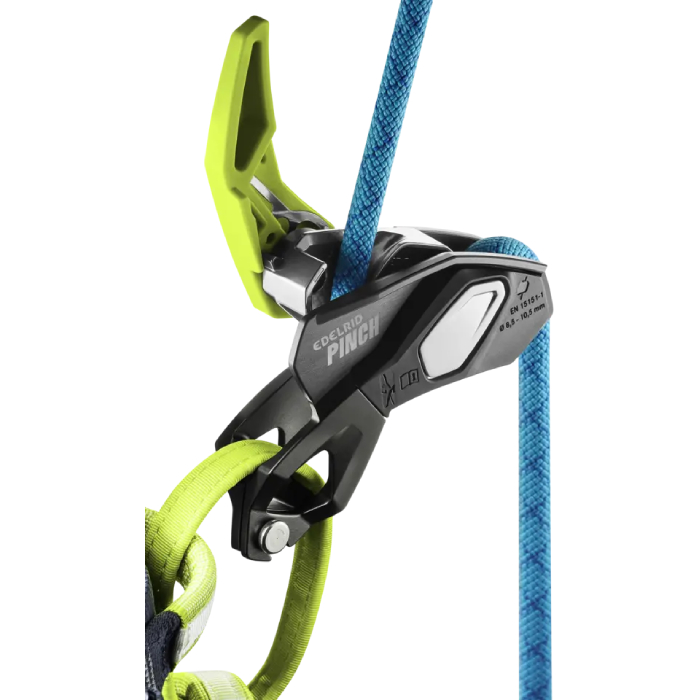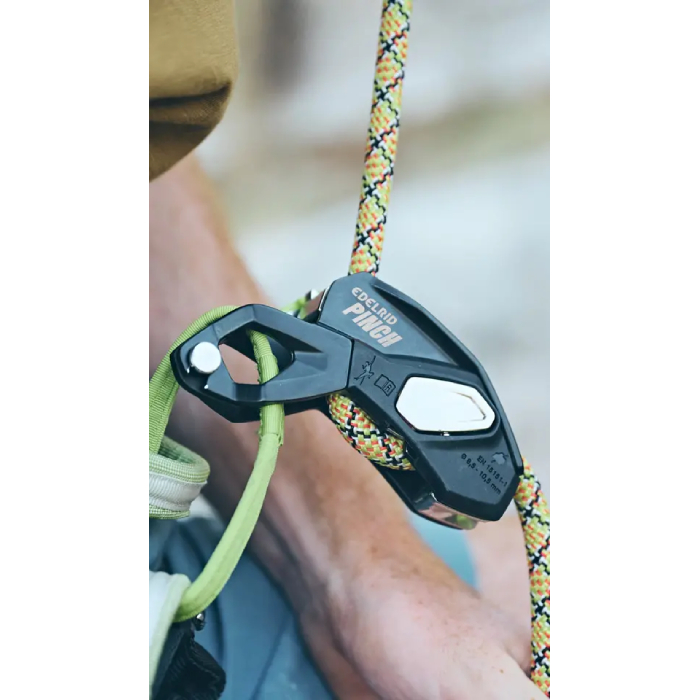Pinch
Description
Pinch - a new belaying experience with the PINCH, a new, versatile assisted braking belay device for use in sport climbing, multi-pitch climbing and rope access techniques. The PINCH is the first device on the market that can be attached directly to the central ring of the climbing harness. Thanks to its low, close-to-the-body position, the PINCH does not need to be fixed in place when releasing the rope and the brake rope can always be gripped with all fingers. In addition, the compact belay system provides an increased span, which allows the belayer to pay out 20 - 30 cm more rope at once. The linear rope run through the frontal steel braking grooves reduces rope tangles when lowering and abseiling. In addition to the release lever, the speed can be controlled by the pressure of the braking hand, which contributes to increased braking rope control, especially when using thin, soft ropes. The anti-panic function provides added safety not only for beginners. A special feature is the integrated second braking tier, which enables controlled lowering by pulling the lowering lever further when securing particularly light persons or in systems with high rope friction. Users and experienced rope access technicians can permanently deactivate the anti-panic function using a screw supplied. Another plus: When used on multi-pitch lengths, the PINCH is the only device on the market that can be attached to the belay station in four different directions in 90° increments. This means that the belay lever can always be brought into a position in which it can be operated freely.
- Assisted braking belay device for versatile use in sport climbing, multi-pitch climbing and rope access techniques
- Position close to the body due to direct harness connection increases brake rope control and improves usability
- Direct harness connection eliminates the risk of cross-loading the belay carabiner
- Anti-panic function can be deactivated for increased safety by automatically locking the device if the release lever is pulled too far backwards
- Second braking tier if the anti-panic function is activated too frequently due to insufficient load and/or excessive rope friction
- Frontal steel brake grooves allow the rope to run linearly and ensure less rope tangling, increased durability and prevent unsightly discoloration that occurs when the rope rubs against aluminium
- Attachment to the stand in four different directions in 90° increments
- Equal operation for right and left-handed users
Retail price
When you click a link below and then checkout online, no matter what you buy (climbing gear or not), we get a small commission that helps us keep this site up-to-date. Thanks!


Device Type  Device TypeTubeThe most commonly used belay type also called an “ATC” or “tuber.” Other than a distinction between other belay device types, “Tube” is a rarely used term, most climbers just assume you're talking about this style when they refer to your "belay device." 
Figure 8Mostly used in rescue, canyoneering, tactical, work safety, or by old school climbers and rappellers. One reason they went out of popularity with recreational climbers is because they tend to create twists in the rope. 
Brake AssistThese devices assist in stopping the rope when a climber falls or hangs on the rope. 
Often referred to as “auto-blocking” but that’s not the official terminology because no belay device should be assumed to work automatically by itself, even if it feels like it does (or does most the time). PlateWhen simplicity is a must, or you started climbing before Tubers were the norm. Bonus: They tend to be very light weight. 
DescenderFor rappelling, not for belaying a lead climber or top-roping.  |
Brake Assist - Mechanical |
Weight (g)  Weight (g)In grams, the weight, as stated by the manufacturer/brand. |
234 g |
Belay Brake Assist  Belay Brake AssistThis is when the belay device significantly reduces the amount of holding power the belayer must exert to stop a fall and hold a climber. This is also called "assisted-braking" as the device must hold a significant amount of the climber’s weight; this term does not include friction-adding "teeth" found on some tube style belay devices. Confusingly referred to as “auto-blocking” or “auto-locking” these terms wrongly imply the device will always, automatically, stop a fall or hold a climber even if the belayer/rappeller is hands-free. These devices are not meant to be used without a hand on the braking side of the rope; the belayers/rapppeller brake hand should always be on the brake rope. Worth ConsideringMost of the mechanical brake assist devices only hold a single strand of rope and are not capable of double-strand rappelling (the most common method of rappel). |
Yes |
| Rope Options | 1 rope only |
Guide Mode  Guide ModeThis is when you belay directly off the anchor instead of your harness. Guide mode is helpful if you climb outdoors a lot because it reduces the holding power required from the belayer. When your partner falls or rests, the weight of the climber is held mostly by the anchor and the belay device. Tubers and PlatesWhen belaying in "guide mode," the tubers and plates turn auto-blocking. During a fall, the climbing rope pinches the slack rope, completely stopping the movement of either rope. A common guide mode setup shown below. 
Mechanical Brake Assist DevicesThere is no difference in the functionality of the device. A brake-hand should always be on the rope to ensure the climber is caught in the case of a fall. A common guide mode setup shown below. 
Where guide mode is used
Learn Morehttp://www.climbing.com/skill/essential-skills-auto-blocking-belay-devices/ |
1 follower only |
Teeth  TeethTeeth are only seen on tube devices. They add friction that helps grip the rope for more belaying control. This is helpful for belaying heavier climbers. Teeth are becoming standard on new tube devices. 
Worth ConsideringTeeth do wear out. You can limit wear by rappelling on the side without teeth (if you don’t need the extra friction). Once they’re worn, you’ll still have a usable belay device, just less friction. |
No |
Rope Range (mm)  Rope Range (mm)The range of rope diameters, in millimeters, that the manufacturer/brand specifies can safely be used. This is the best case scenario and does not necessarily take into consideration that certified ropes have a tolerance of +/- .3 mm. Recently, manufacturers have started to add an "optimized" rope range -- this is the range that will result in the nicest handling of the belay device. | 8.5 mm - 10.5 mm |
Certification  CertificationsThe main climbing gear certifications are CE and UIAA--and normally the UIAA creates the rules that the CE body also supports. When possible, we try to list all the certifications the product carries. To sell a climbing product in Europe, the device must be CE certified. There are no official requirements to sell climbing gear in the US. The UIAA certification is a voluntary process. Learn MoreRock and Ice Certifications Guide |
EN |
No reviews yet.
With the Pinch, Edelrid have done something distinctly Edelrid, by taking a completely fresh look at a product and category that has seen little decent innovation in years. The result is a bit of a game changer. I really like the fact you can attach it directly to your belay loop, as this gives you much more precise performance. And in contrast to most designs of assisted braking device, which tend to need a practised knack, its intuitive functionality will appeal to beginners and experienced climbers alike. So going forward, will I be using the Pinch in preference to the GriGri? Yes, absolutely.
The Edelrid Pinch is my new go-to belay device. Every assisted belay device has compromises, but the Pinch has the correct alchemy of characteristics for me. Admittedly, it also handles most closely to a GRIGRI, and adopted familiarity is a big plus. The Edelrid Pinch also connects directly to the belay loop, delivering advantages that vaulted the device to the top of my list.
Moreover, its versatile design enables attachment to belay stations in four different directions, providing unparalleled flexibility for multi-pitch climbs. This way, the Pinch offers a 90-degree turn at the belay station. Due to its almost symmetrical design, the Pinch can also be operated by left- and right-handed people. Furthermore, the device is double-certified and can be used for rope access and route setting. "The Pinch is simply the most versatile device out there now and can be handled more efficiently than any other", Philippe Westenberger sums up the benefits of the Edelrid latest belay device innovation.


